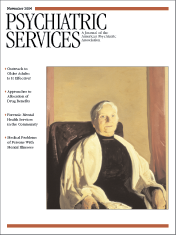Reducing Assaults Among Hospitalized Youths
In Reply: Dr. Whelan raises several important points in his comments about our article. Caregivers, teachers, and hospital staff members often see oppositional behaviors as best met by behavioral contingencies designed to operantly teach adaptive behaviors. Such responses overlook the fact that such behaviors in children and adolescents, who are typically hospitalized because of significant problems with impulsivity, affect regulation, and behavioral dyscontrol, often reflect expressions of frustration, efforts to demonstrate autonomy, a desire for engagement, or some other meaningful interpersonal transaction.
We appreciate Dr. Whelan's noting the importance of considering behavioral management systems as possible catalysts in negative interactions between patients and staff on a unit. We also agree with his observations and conclusion that the transactional nature of patient-staff interactions is typically not addressed in an effective manner. As clinicians who have worked in inpatient settings and have also observed firsthand the limitations of level-based behavioral management systems, we were still surprised by the high rate of assault on staff. In the hospital in which this study took place, there have been ongoing and successful efforts to decrease seclusion and restraint. However, we wonder whether such efforts may inevitably plateau in their success and even have the unfortunate "side effect" of facilitating other forms of dyscontrol within the confines of traditional level-based behavioral management systems.
One of us attended a workshop at the annual meeting of the American Academy of Child and Adolescent Psychiatry in October 2003 (1) in which Ross Greene discussed CPS (2) and its role in eliminating the use of seclusion and restraint in an inpatient setting very similar to the one in our study. One of the many reasons that we perceive the CPS approach to be effective is that it addresses the main reason that people choose to work with difficult children for low pay—to help them. As Dr. Whelan states, CPS "emphasizes discovering the specific pattern of cognitive skill deficits implicated in a given child's inability to comply and works to remediate these deficits." Our observation has been that efforts to address the transactional component between staff and patients often convey to staff that they are doing something "wrong" and that they are somehow inappropriately implementing the otherwise effective unit management program. CPS focuses on therapeutic interactions rather than on limit setting, in which there is inevitably a winner and a loser.
Dr. Whelan suggests that it would have been of value to record "situation-specific, verbatim data" for the verbal reprimands given to patients. Again, he makes a good point. However, such an effort would capture only one element of the transaction in the microclimate of the inpatient unit. There are many other facets of the interaction that would likely affect the transaction, such as a staff member's reputation with patients on the unit, the tone of voice used, the staff member's familiarity with that patient, and the patient's familiarity with the level system.
1. Hassuk B, Greene W, Regan K, et al: Elimination of Restraint and Seclusion in Inpatient Child Psychiatry. Workshop presented at the annual meeting of the American Academy of Child and Adolescent Psychiatry, Miami Beach, Florida, October 14–19, 2003Google Scholar
2. Greene RW, Ablon JS, Goring JC: A transactional model of oppositional behavior: underpinnings of the collaborative problem solving approach. Journal of Psychosomatic Research 55:67–75, 2003Crossref, Medline, Google Scholar



